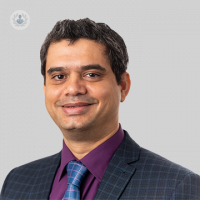Latest advances in sciatica treatment and pain management
Escrito por:Sciatica is the sharp pain that emanates from the lower back and to the leg. It is caused by compression, inflammation or irritation of the sciatic nerve that travels from the buttocks and down each leg. It is most often caused when by a herniated disc or an overgrowth of bone puts pressure on the spine nerve roots. In this article, a consultant pain physician and intervention specialist explores treatment options and pain management methods for sciatica.

The pain can feel like a jolt or an electric shock and may be accompanied by numbness, tingling, or muscle weakness in a leg or foot.
Whilst sciatica is normally considered nonserious and for mild cases, it can be treated with simple painkiller medications – as symptoms are typically expected to improve within 12 weeks. These medications can be NSAIDS like ibuprofen or aspirin and can be bought over the counter, or prescribed medications like opioid analgesics like oxycodone and tramadol, or oral steroids like prednisone. Some patients may be recommended to manage their weight to reduce spinal pressure. Aside from painkillers, there are other conservative treatment options:
Steroid injections
Injections of corticosteroid medication and local anaesthetics into the epidural space in the spine or around where the sciatic nerve meets the nerve root, called a nerve root block. This can alleviate the pain almost immediately and decisively, and one injection may be sufficient at a time. They work to:
- Reduce inflammation
- Relieve pain
- Allow movement
Epidural steroid injections are able to eliminate pain along the whole spine, whereas a nerve root block localises the pain locally.
Physiotherapy
Most doctors will recommend physiotherapy first as this is a way to prevent further pain whilst also reducing inflammation. It works by stimulating and strengthening the muscles around the spine, providing long-term support and facilitating the body’s recovery from sciatica. Physiotherapy can take the form of stretches, walking, yoga, swimming, and resistance training. The aim is to improve flexibility, improve posture, and strengthen the core and back muscles so that sitting, standing, and lying down is not uncomfortable.
Hot and Cold Therapy
Alternating between a hot and cold pack can promote healing and relieve pain by increasing circulation and decreasing inflammation. can promote healing and relieve pain. The cold acts as a pain reduction by cooling the muscle fibres and constricting the blood vessels to create a numbing sensation, whereas heat relaxes the muscles and stimulates the tissues' metabolism. As you alternate with heat and ice, the ice decreases inflammation, and the heat increases circulation. The reduced inflammation relieves pain, while the increased circulation encourages healing.
If even after conservative treatment the sciatica pain continues or progresses, and the patient is struggling with related issues of urinary incontinence or complete numbness, then surgery can be considered. Surgical procedures will fuse the spine or remove the herniating disc. Eighty per cent of patients who have gone through surgery have reported that they are leg pain-free afterwards, and most will remain so for at least five years after surgery.
Microdiscectomy
A lumbar microdiscectomy is when the herniated section of a lumbar disc that is causing sciatic pain is removed through a small incision to relieve pressure on the nerve. It is usually an outpatient procedure and takes around two hours. Patients may be recommended to wear a back brace as they recover to protect the wound. Healing time can be up to a year, but patients can return to driving and light activities after two weeks, with avoidance of bending, twisting, or lifting for up to six weeks.
Laminectomy
If the sciatica is caused by bone spurs or spinal stenosis (where the spaces in the spine narrow), then a laminectomy may be suggested. In this procedure, the lamina section of the vertebrae, which act as the roof of the spinal canal, is removed which allows more space for the spinal nerves and relieves pressure. This can be performed as an open surgery or with minimally invasive techniques, and patients will stay in the hospital for a couple of nights. The recovery time from this procedure is similar to that of a microdiscectomy.
Transforaminal endoscopic lumbar decompression
Transforaminal endoscopic lumbar decompression (TFELD) is a minimally invasive procedure that frees the nerves inside the foramen, which is the hollow bone tunnel where the spinal cord exits the bone and into the legs. This surgery widens the space to relieve pressure via a small incision on the back and an endoscope.
Unilateral biportal endoscopic lumbar discectomy
One of the newest techniques for surgically treating sciatica pain is a unilateral biportal endoscopic lumbar discectomy (UBELD), in which the entire herniated lumbar disc is removed to improve function and relieve pain. This is also used to reduce the risk of dural sac tearing, cerebrospinal fluid leakage, and epidural hematoma, which is where a collection of blood forms between the skull and the outermost membrane around the brain.
If you have lower back pain and would like to explore your options for relief, you can consult with a specialist via Top Doctors.


